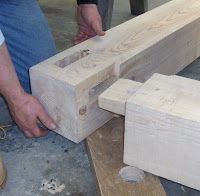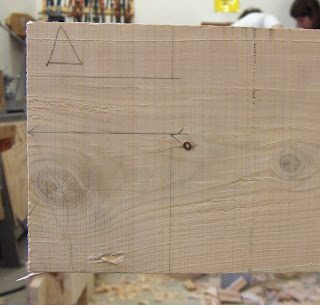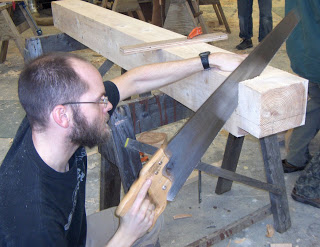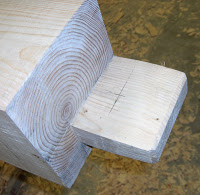 In my last post, I wrote about using the square rule to make my timber a uniform dimension at the joint locations. This week, I'll show briefly how to lay out and cut one tenon on a specific post using the square rule. The tenon is made to fit into a mortise in the plate which will eventually support the rafters and roof of the shed, so these joints must be nearly perfect. A good square and sharp pencil are crucial to getting these joints to work well.
In my last post, I wrote about using the square rule to make my timber a uniform dimension at the joint locations. This week, I'll show briefly how to lay out and cut one tenon on a specific post using the square rule. The tenon is made to fit into a mortise in the plate which will eventually support the rafters and roof of the shed, so these joints must be nearly perfect. A good square and sharp pencil are crucial to getting these joints to work well.
 In this picture, you can see the reference face of my post designated by the dark triangle pointing to the reference edge. The reference faces are the most square to each other, so we'll base all of our measurements from those faces. The photo also shows how I laid out my pencil lines for the tenon. The tenon is 1.5 inches from the reference face and 1.5 inches in thickness. One leg of my framing square is 1.5 inches, so it makes things a lot easier.
In this picture, you can see the reference face of my post designated by the dark triangle pointing to the reference edge. The reference faces are the most square to each other, so we'll base all of our measurements from those faces. The photo also shows how I laid out my pencil lines for the tenon. The tenon is 1.5 inches from the reference face and 1.5 inches in thickness. One leg of my framing square is 1.5 inches, so it makes things a lot easier.
There's more to layout than what's shown and you'll want to do all of that before cutting, but for simplicity, I'll move on. The first cut is with a carpenter's crosscut saw. It's pretty hard to do well and I have a lot to improve technique-wise.
 Once the majority of the meat is cut away from both sides of the tenon, the tenon's "cheeks" are cleaned up and flattened with a chisel and rabbet plane.
Once the majority of the meat is cut away from both sides of the tenon, the tenon's "cheeks" are cleaned up and flattened with a chisel and rabbet plane.
After planing, I removed the parts of the tenon that will make it 4.5 inches across as well as the housing that will help the tenon slide right into it's mortise. A slight taper on the tenon's faces, chamfers on it's edges and ends, and a peg hole and it's all done.
I'll post some photos from our shed raising in the next and last edition of my timberframing overview - probably next week.

